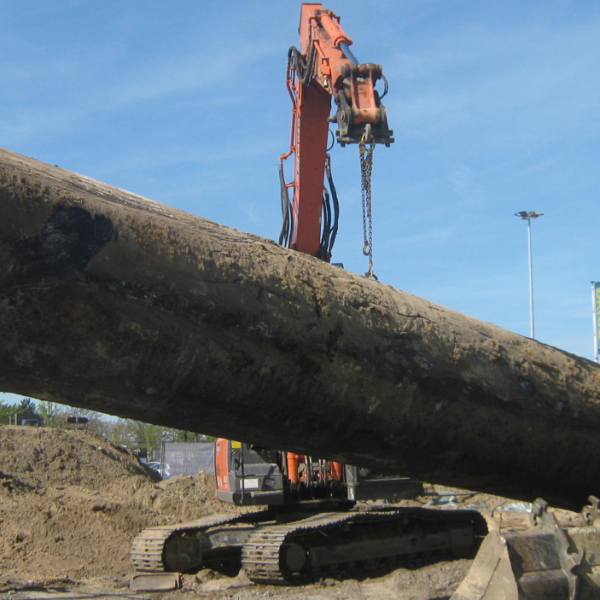Soil and ground water contamination at Cokes Plant

The operations of the cokes plant on the site of the former Cokeries du Brabant has resulted in a number of historical soil and ground water contaminations. Witteveen+Bos is guiding De Vlaamse Waterweg (the owner of the site) through the process of soil remediation.
The cokes plant was in use from the 1920s to the 1970s. In the 1970s, the activities were ceased, the plant was demolished and the site was redeveloped. Various other activities were subsequently undertaken on the site, including the storage and transshipment of goods, a concrete mixing plant and a fuel depot.
The soil contamination at the site primarily stems from the cokes plant and consists of contaminations with typical gas factory pollutants, such as: mineral oil, PAHs and BTEX, phenols and NSO compounds, as well as cyanides.
Soil investigation provides insight into the nature of the contamination and dispersion risks
Using innovative measuring methods, such as: EnISSA, OIP and flux measurements, we were able to characterize the contamination more specifically. This resulted in an improved overview of the dispersion of the contamination in the deeper ground water layers and of the occurrence of pure product in the soil.
The additional research resulted in a major conclusion, namely that the soil contamination by organic parameters (PAH, mineral oil, BTEX) has not resulted in a significant dispersion risk. We also implemented classic sampling techniques using monitoring wells, for continuous evaluation of the dispersion. This is the case for the cyanide contamination present in the ground water.
Preparation of the concession and remediation of the Northern sub-site
Witteveen+Bos guided De Vlaamse Waterweg through the process of awarding a concession of the Northern sub-site, an unused area, of the former cokes plant. We used our expertise with regard to soil legislation, so that the execution of the soil remediation would form an important condition to obtain the concession.
The soil remediation of the contaminations in this sub-site has since been taken over by the new concessionaire. In order to ensure that the new concession was not complicated unnecessarily, De Vlaamse Waterweg adopted the obligation to perform remediation related to the activities of the fuel storage activities prior to the transfer. We also advised our client during this process.
The results of our research allow us to describe the impact of the remediation and the associated costs. The resulting benefit is two-fold:
- The concessionaire can make a substantiated offer for this sub-site based on this estimate;
- De Vlaamse Waterweg can use this input to incorporate the financial impact of remediation activities in the concession agreement. This way any risks associated with additional costs for performing the remediation for De Vlaamse Waterweg are avoided.
Witteveen+Bos performed additional soil analysis in preparation of the specifications for the new concession. We were able to detect a few significant impediments to the remediation process and to calculate the remediation costs.
Additional analyses resulted in improved characterisation of the vertical dispersion of the pure product by means of OIP measurements. By means of a trench campaign the contamination in the upper layer of the soil was studied in more detail. We did this not only to get a better picture of the extent and severity of the contamination, but also to determine the processability of the materials in question. During a trench campaign, we also detected asbestos in the soil, which needed further research into the processability of soils that contain both asbestos and cyanide contamination.
Increased concentration of cyanides in surface water
The activities of the cokes plant have resulted in increased concentrations of cyanides in the surface water in the ditches downstream of the site. Analysis revealed that the cyanides, which are found in the sludge of these watercourses, form an important source of contamination. Witteveen+Bos also characterized this contamination in more detail and estimated the risk. The remediation of this contamination is also the responsibility of the new concessionaire.
Removal of the source of cyanide contamination
On the southern sub-site where activities are currently still taking place, we identified a significant source of cyanide contamination in the ground water near the pond, which collects the industrial site’s rainwater.
A ground water model and additional (deeper) drillings were used to determine the extent of this contamination in more detail. This contamination should be tackled as a matter of priority. The contaminated soil should be excavated and processed externally, in order to prevent a further influx of cyanides. We have drafted a soil remediation project for this.
However, the remediation will be hampered significantly by the fact that the pond is a known breeding site for amphibians. Furthermore, a part of this zone was characterised as forest. This fact is taken into consideration in the development of the remediation plan in order to protect the natural environment as much as possible during the remediation process and to encourage development of the natural environment as much as possible after the remediation process.
Plume strategy cyanide contamination
The severity of the cyanide contamination in the ground water necessitates an active approach, for which we started a number of feasibility tests in order to determine the actual plan. Due to the nature of the contamination (non-biodegradable, non-volatile, limited absorption), this remediation should be performed using an innovative technology. The preparatory investigation is currently taking place.
In the interim period before remediation takes place, the ground water contamination will be monitored to rule out any dispersion and to implement additional measures in a timely manner. Monitoring plans will be implemented, with monitoring wells being used for the additional analyses.
More Information?



